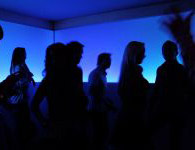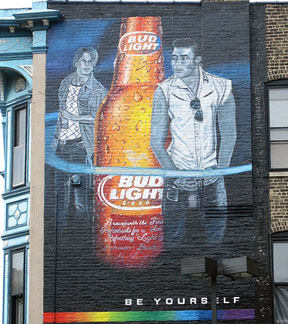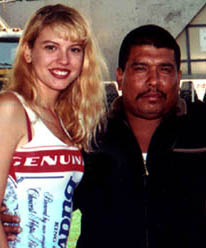Big Alcohol 101-slider
[showplus] Critical error: Image folder root/images/watchdoggoing/bigalcohol101/slider specified in the administration back-end does not exist or is inaccessible.
Error
[showplus] Critical error: Image folder root/images/watchdoggoing/bigalcohol101/slider specified in the administration back-end does not exist or is inaccessible.
Tactic: Marketing to Target Populations
Big Alcohol is backed by a multi-billion dollar marketing machine. And while the alcohol industry is by no means alone in its saturating approach to advertising, it is with one of the most well-funded, most powerful players in the marketing game.
The alcohol industry’s success requires a steadfast effort to target several specific populations to ensure that alcohol is woven into as many parts of their lives as possible.
Youth
 |
There’s little doubt that more ad exposure = more underage drinking. In one recent example, a 2007 study of middle schoolers found that exposure to ads influences not only teens actual drinking, but their plans to drink in the future.
The alcohol industry seeks to act like the wallpaper in young people’s lives. And, whether or not a young person can recall consciously seeing or hearing an ad or sponsorship messages doesn’t matter. Research shows that even the ads teens don’t recall later can impact their behavior.
TV ads for alcoholic products are just the tip of the iceberg. Many brands are branching out to new media in order to reach young audiences. Anheuser Busch’s products, for example, are heavily advertised between mobil phone content and on popular music and event sites such as Pandora and Flavorpill. Also, alcohol giant Diageo has begun sponsoring mock bars within the reality game, Second Life.
Related Links:
Alcohol and Youth Fact Sheet
Stop Alcopops Campaign
Related News:
When Getting Drunk Is Cheap
The Lesbian, Gay, Bisexual and Transgender (LGBT) Community
 |
The rates of alcohol consumption and alcohol problems are higher among lesbians and gay men than in the general population. Even worse, LGBT youths appear to use alcohol and other drugs more than other youth. Could it be a coincidence, then, that this group is bombarded with suggestive advertising?
Alcohol brands such as Jim Beam bourbon whisky, Smirnoff and Absolut vodka which were amongst the earliest mainstream brands to target advertising directly at gay consumers in gay media.
Today, according to the Human Rights Campaign, “Alcohol is by far the most crowded category in gay marketing, with more than 40 brands jostling for attention.” Absolut vodka, for instance has been advertising to LGBT folks for over 17 years. Miller Brewing Co. has also been in the gay media since the mid-1970s and is the official sponsor of the International Gay Rodeo Association. The Coors brand has gone from being boycotted by gay activists in the 70s and 80s to blatantly courting gay consumers in the 90s.
Related link:
Snapshot: MolsonCoors
Women
If we are to believe the advertisements, we might think that women are as excited about buying alcohol as they are about stripping down to their bikinis. In reality, the industry works very hard to maintain an active female consumer base with a symbiotic loop between marketing and product development.
If you’re young, that means alcopops of a wide variety of flavors that are reminiscent of candy (see Alcopops). If you’re a little older, it means everything from a “low-alcohol” wine (that still rings in at 9%) to a new high-end vodka/champagne/fruit juice mix called Nuvo.
In one 2006 study, a significant rise in binge drinking rates among girls was found to be the direct product of advertisements that portray women drinking beer and alcopops as part of their full and active lives.
Related Links:
Chicago Tribune: Booze ads blamed in new trend
People of Color
 |
As the U.S. becomes increasingly more diverse, Big Alcohol makes it a point to reach out to people of color. Latinos, the fastest growing population, have been hit hard by alcohol advertisement, sponsorship and the co-opting of cultural holidays such as Cinco De Mayo and Carnival. In 2006, Anheuser-Busch launched a $60 million Hispanic marketing campaign.
African-American communities are also commonly targeted; in addition to the availability of large quantities of low-cost alcohol on every corner, the industry places a disproportionate number of billboards and transport ads in black neighborhoods. They also ensure that media sources such as Black Entertainment Television (BET) are saturated with alcohol ads and that nearly half of all rap songs have some reference to an alcoholic beverage.
Related Links:
African-American Youth and Alcohol Advertising
Public Relations Tactics
Drink Responsibly
Self-Regulation
Industry Funding
Ineffective Educational Programs
Producers
SABMiller
Molson Coors
Heinekin
Diageo
Constellation Brands
Pernod Ricard
Bacardi
Brown-Forman
Beam Treasury
Campari
Patron
Remy Cointreau
Gallo
Bronco
The Wine Group
Trinchero
Trade/Front Groups
- Beer Institute
- Brewers Association
- Craft Brewers
- Wine Institute
- DISCUS
- FAAR
- FW of CA
- Craft Distillers
- Global Alcohol Producers Group
- ICAP
Industry Tactics
Industry Agenda
Lower/Remove taxes & fees
Expand advertising & promotion
Expand access/availability
Increase profit to owners/shareholders
Publications
Help us hold Big Alcohol accountable for the harm its products cause.
| GET ACTION ALERTS AND eNEWS |
STAY CONNECTED    |
CONTACT US 24 Belvedere St. San Rafael, CA 94901 415-456-5692 |
SUPPORT US Terms of Service & Privacy Policy |


